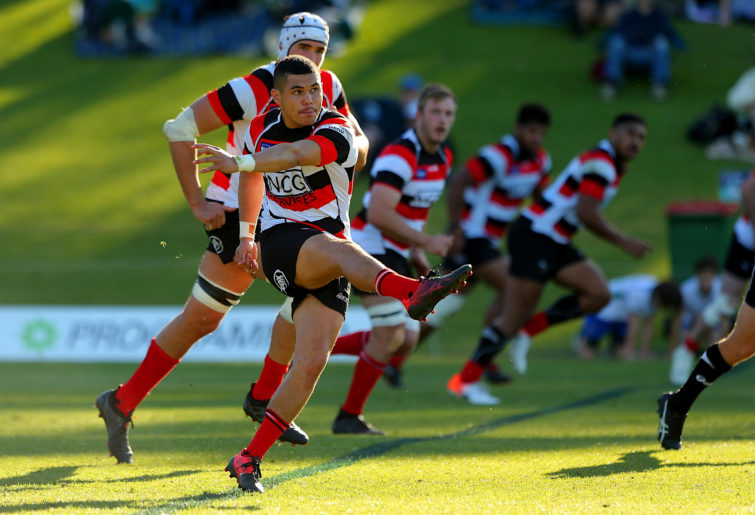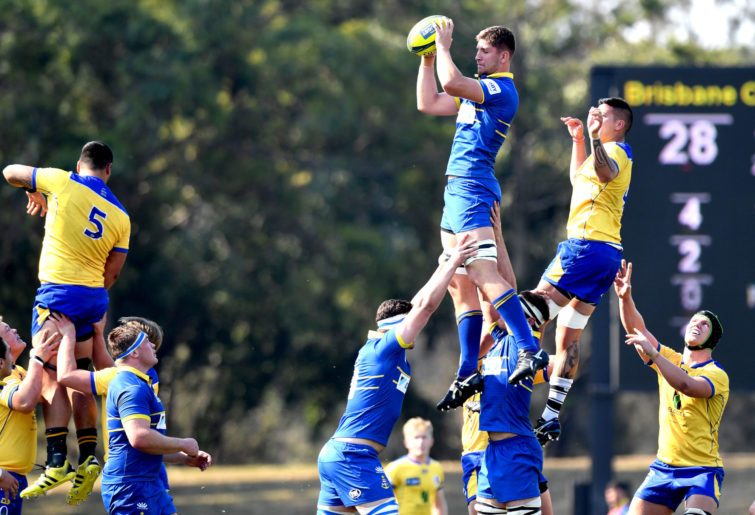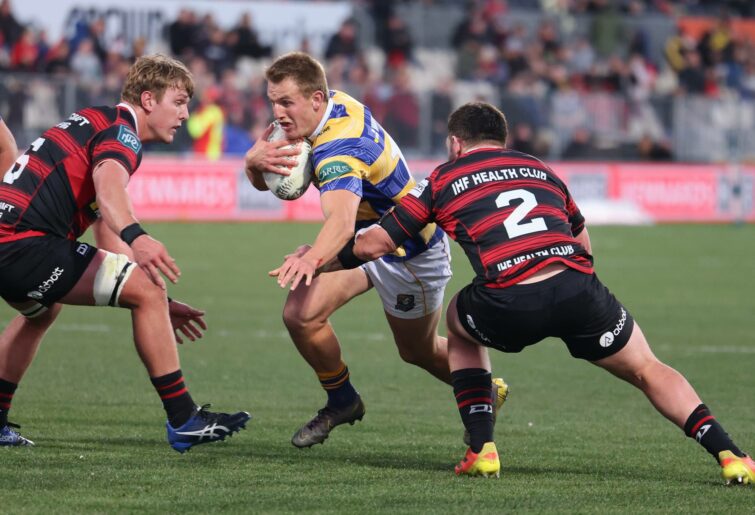Australian rugby is on the move, in every sense of the word. But where it is moving to is the critical question.
In a bombshell series of announcements on Tuesday last week, Rugby Australia confirmed a packed 2025 British & Irish Lions schedule (including a potential ANZAC cvrossover Test match at Adelaide Oval), an unofficial sign off on its looming private equity bid, and significant progress being made in partnership with the New Zealand Rugby Union towards a Super Rugby commission, with plans to have a figurehead in place by the end of winter. Throw in a later announcement late last week of a landmark deal with Japan, and things are certainly looking more interesting for the coming decade of our game.

(Photo by Matt King/Getty Images for Rugby Australia)
However, another announcement that turned heads was plans for a new eight-week crossover competition involving the Shute Shield and Hospital Cup, to try and give Australian players critical game time and get them up to a level comparable with their Tasman counterparts.
“People are now making a choice about whether they go to club games or whether they go to Super Rugby games and when I was playing, you’d go to your club game and then you’d support your club players at the Super Rugby game,” said Waugh in his maiden CEO address back in June.
“It’s really important that we actually go back to that and we put our best players and Super players into clubs. Then we bring the club supporters into Super Rugby and into Test matches. I know it sounds pretty logical, but I do think there’s been a huge separation over time.
“So how do we actually connect our rugby community and ensure that the game starts and ends in our clubs, and we need to be invested in that space.”
The news of a club competition had reportedly been on the table of Waugh’s predecessor, Andy Marinos, for several years, following the cancellation of the National Rugby Championship (NRC) at the the onset of the COVID pandemic.

Noah Lolesio with the Canberra Vikings (Photo by James Worsfold/Getty Images)
Waugh has looked to make addressing the Australian pathways a key priority of his time in the role, including the creation of a Western Sydney Rugby academy as outlined in an interview with the Australian Financial Review back in June.
It is incredibly positive that Waugh is making the pathways a priority. While a competition that endured a mixed reception during its tenure, conversations around the NRC and Australia’s third tier have, interestingly, only intensified since the last whistle blew in Perth in 2019.
More than anything, the competition showcased to players and Australian rugby punters that there was a need for something to bridge the gap between Australia’s clubland and Super Rugby, similar to corresponding competitions in New Zealand, South Africa and Europe.
Yet, the reception around this proposed club competition has been, in all honesty, mixed at best. While players in those respective club competitions have been supportive, most notably Sydney Uni captain Angus Allen to rugby.com.au after his side’s 45-19 win over Brisbane Premiers Wests during their annual Australian Club Championship fixture in March, fans and commentators have been less supportive.
Even Geoff Parkes has dismissed the idea as a “band-aid solution that pits professional players against club players, and shines a spotlight on Australian rugby’s geographic imbalance problem”, writing in his extensive wrap on Monday that Australia’s current rugby system is “broken.”
If Waugh is serious about addressing this increasingly discussed part of our game, what the makeup of this critical piece of Australia’s pathway infrastructure will be will say a lot about what the focus of his vision is. Put simply, a lot is riding on that vision, given the state of our success-starved professional game.
The KEY issue we need to discuss with Australia’s third tier
I’ve been very lucky that I’ve had the chance to cover this side of Australian rugby for nearly a decade, in addition to liaising with many brilliant rugby minds both here at The Roar and externally who’ve also taken the time to look at this topic.
They will all tell you the same, obvious, thing: Australian rugby is extremely complex and no solution is perfect, and that Australian rugby fans aren’t afraid to tell you EXACTLY what they think should be the solution, almost to the point that any other solution except theirs sucks.
Frankly, it’s understandable people are passionate about this, because all of us want the same thing: a pathway that WORKS!
So, if we are to achieve that, we MUST come to an agreement on a key issue: what is the purpose that a third tier would serve?
This may seem basic; but addressing this issue is important for two key reasons: firstly, the conflict on its purpose was a major reason why people thought the NRC, and indeed, its predecessor the ARC, was a failure in the first place.
Does this competition serve as a pure, player development tool? Or is it meant to grow fans and followers of the game, and be profitable? This has been the dichotomy of much of the discourse between fans online, and while many may think there is a solution that fixes both (the amount of articles on this platform alone proposing new competition strategies are borderline endless), keep on reading as to how difficult such a goal actually is.

Ryan McCauley of Sydney competes at the lineout during the round 2 NRC match between Brisbane City and Sydney at Bond University on September 08, 2019 in Gold Coast, Australia. (Photo by Bradley Kanaris/Getty Images)
Secondly, having an agreed sense of the purpose of a competition means it can help determine the makeup of future iterations. What you’re trying to achieve determines the competition you have.
This is critical for many things, not just because it’s a means of outlining success or failure in the product, but also for the not-so-small issue of how to pay for it.
For reference, New Zealand’s NPC competition runs at a financial loss, and many clubs in that comp have barely ever turned over a profit. Unfortunately, there’s little interest outside of the diehard supporters of those clubs. However, for New Zealand they can afford to take the financial hit: they’ve accepted and identified that the NPC is a pure development pathway that they appropriately fund to ensure success at higher levels, and they are able to recoup the financial losses down the track, such is the financial pulling power of the All Blacks brand.

(Photo by Peter Meecham/Getty Images)
Australia does not have the luxury of programs like those in New Zealand and South Africa. Therein lies many multi-million dollar questions. Where will the money come from? Will private equity be interested in something they can’t make money off, at least for the first few seasons of such a competition? Is Rugby Australia willing to sink, at cost, whatever it will take per year to run a proper third tier that supports our five Super Rugby franchises? Or could the competition be modeled on something that is commercially viable?
It’s a tough position for Waugh to be in. In his eyes (at least publicly), going to clubland is the solution to reinvigorate fans. There is his focus: connecting the rugby community. Engaging the fans. It’s an admirable goal and his heart is in the right place, but is it the right solution?
Australia might not have the infrastructure, but we do have a very strong clubland system and passionate fans. I’d hope that in my time covering the world of third tier competitions and premier grade clubland nationwide that I can do the real complexity of our national game justice.
For me, there are only three options for Australian rugby. None of these solutions are perfect, but each aims to try and address the two key challenges mentioned earlier, plus also address the key hurdle of funding.
We ask ourselves: what does success look like for Australian rugby? For me, that answer is tied up with what such a third tier looks like. We need to make the choice as to what we value for the game, and in my eyes you need something that not only improves our Super Rugby sides above, but enhances our premier grade competitions below.
So, what are my options for Australian rugby? Read part two now to find out.
































































































